|
The United States Coast
Guard
World War I and Interwar Years
.
| On 6 April 1917, the United States declared
war on Germany, and the US Coast Guard went into battle with 15 oceanic
cutters manned by over 5,000 sailors.
The Coast Guard performed convoy escort duty
alongside the Navy, hunted U-boats and enemy commerce raiders, and established
an American Patrol Detachments across the North Atlantic.
Coast Guard squadrons, each composed of six
armed cruising cutters, operated from British Gibraltar into the Mediterranean;
around the Azores, off Nova Scotia in the freezing North Atlantic; throughout
the Caribbean Sea, and all along American coastal waters. |
.v |
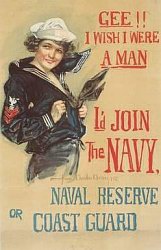 Recruitment Poster
Recruitment Poster
|
.
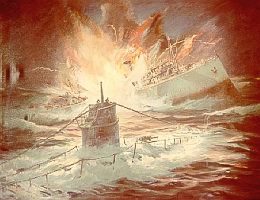 One hundred-eleven Coast Guard
members perished during the attack of the Tampa.
One hundred-eleven Coast Guard
members perished during the attack of the Tampa.
|
.. |
The Coast Guard performed many deeds of heroism
and again paid a heavy price. During the war, the relatively small Coast
Guard suffered the greatest proportional loss of America's armed forces.
Most of this loss was due to ferocious ocean gales and attacks from U-boats.
The greatest loss was the German submarine
torpedo attack against the cutter
Tampa during a storm on 26 September
1918, which sent her to the bottom near Gibraltar with all hands. |
.
| To release more men for combat, the Navy considered to use women
in secretarial and clerical jobs. On March 19, 1917, it authorized the
enlistment of women in the Naval Reserve, with the rating "Yeoman (F).
These women were popular labeled "Yeomanettes."
Soon afterwards, the Coast Guard followed the Navy's policy and recruited
women as well. Unfortunatley, there is not much known about these Coast
Guard Yeomanettes. A few were employed at the diminutive Coast Guard headquarters
building in Washington. The first uniformed women in the Coast Guard became
nineteen-year-old twin sisters Genevieve and Lucille Baker who transferred
from the Naval Coastal Defense Reserve. After the end of war, the Navy
and Coast Guard Yeomanettes were mustered out of service. |
... |
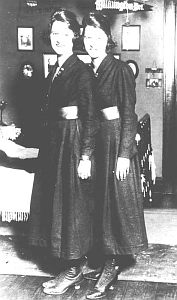 Coast Guard Yeomanettes,
Coast Guard Yeomanettes,
ca. 1918
|
.
Following World War I, the US Coast Guard
returned to peacetime legal and maritime safety duties of the Treasury
Department. It entered a dangerous conflict against bootleggers and well-armed
gangsters in an effort to enforce prohibition laws against smuggling alcohol
into America. This little-known port and river conflict added a thrilling
chapter to Coast Guard law enforcement history.
.

Edgartown Harbor Cast-Iron Light
Tower in 1939
|
.v |
Maintaining and operating the innumerable
lighthouses dotting the American shoreline was added to Coast Guard responsibility
in 1939.
The Coast Guard expanded its wartime readiness
in reaction to President Roosevelt's proclamation of a National Emergency
on 8 September 1939. |
.
| From this date until America's actual entry
into World War II following Pearl Harbor, the US Coast Guard fought the
Battle of the Atlantic against German submarines.
Although America insisted that it was neutral,
President Roosevelt organized U-boat countermeasures as part of his "Neutrality
Patrol" system of aircraft and warship-escorted convoys.
Modernized Coast Guard cutters performed valuable
service on the Greenland Patrol and established a weather observation service
for the Atlantic Ocean. Meanwhile, the service almost doubled the number
of personnel from 17,002 in September 1939 to 29,978 by December 1941. |
.v |

The Coast Guard Cutter Bear
in
the ice during the 1939-1940 Antarctic expedition.
|
.
The US Coast Guard enjoyed a premier historical
reputation for social progress and brave humanitarian work in peace and
war, which had endeared it to the country. The seaside communities of America
were eager to assist ongoing wartime preparation efforts.
.
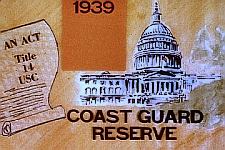 |
... |
Coast Guard Reserve and Auxiliary Act, passed
on 23 June 1939, enabled civilian boat and yacht owners to integrate their
services into Coast Guard activity. This became the Coast Guard Auxiliary
by Congressional Acts of February and March 1941. |
.
The same acts also permitted a Coast Guard
Reserve that closely followed the Navy Reserve, except that it allowed
for temporary members on a partial or non-paid basis. This auxiliary force
already summoned over 4,500 motorboats and yachts in 216 flotillas for
Coast Guard offshore and coastal work when the war began.
.
Coast Guard Auxiliarists
.
This Coast Guard association was an arrangement
that did not bestow law enforcement authority, but allowed volunteers to
spend spare hours in their own sea-craft patrolling various waterways while
looking for possible enemy aircraft, submarines, or other suspicious activity
(in the early war stages, saboteurs were widely reported).
.
| The logo of the Coast Guard
Auxiliary adopted during WWII featured Donald Duck dressed as a pirate,
policing the coastal haunts of Blackbeard.
The logo was designed by Walt
Disney for the Coast Guard Auxiliary which was also known as the Corsair
Fleet. |
.v |

|
.
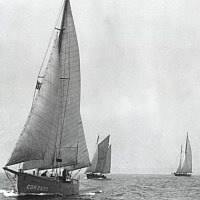
Coastal Picket Force vessels of
the Coast Guard Reserve (CGR) en route to grid patrol areas, ca. 1942.
|
... |
The flotilla was the basic unit of the Coast
Guard Reservists which consisted of ten or more boats. A flotilla was led
by an elected civilian with the title of Flotilla Commander who was assisted
by a Vice Commander and a Junior Commander. A division was composed of
five or more flotillas with an elected Division Captain, Vice Captain,
and Junior Captain at its head.
The administration of the Reserve was devided
into fourteen districts (corresponding to the naval districts established
by the Navy Department) and each district was administered by a civilan
District Commodore and Vice Commodore. A regular officer of the Coats Guard
with the title of Chief Director of the Reserve would administer the Reserve
assisted by fourteen District Directors. |
.
| Left: Collar rank insignia
of Flotilla Commander. It was also worn on the right side of the garrison
cap
Right: Lapel insignia
of the Coast Guard Auxiliary. It was also worn on the left side of the
garrison cap |
.v |
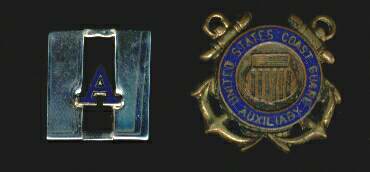 |
.
The Coast Guard Auxiliary, formed in 1939, included
female volunteers who owned their own motorboats and yachts, or served
as part of family crews. Female Auxiliarists were invariably well-to-do,
because they owned their own boats. Most were young yachting and sailing
enthusiasts, including society notables esteemed as yachting champions
or sailboat race winners. Their uniforms consisted of auxiliary insignia
on sporty sailing outfits embellished with military accessories, so that
drab uniformity was often enlivened by the summery attire of youthful female
skippers. Later the uniforms of the SPARS were adopted and worn with distinctive
auxiliary insignia.
.
| The Auxiliary grew to 11,500 members by June
1942. Many (mostly men) later became Coast Guard temporary reservists,
as allowed by the Auxiliary and Reserve Act of 19 February 1941, amended
in June 1942.
These "coast guard police" volunteers served
mostly on a completely voluntary basis without compensation. They helped
safeguard America's otherwise unguarded eastern and western shorelines,
the Intercoastal Waterway and many uncharted swamp outlets, estuaries and
other outlets to the sea. In November 1943, congressional legislation allowed
women to enroll as temporary Reservists, too. |
.. |
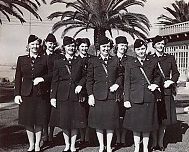
Women temporary reservists in
World War II
|
.
.
[ I. Development ]..[
II. Facts about the SPARS ]..[
III. Uniforms ]..[
IV. Sources ]
|
